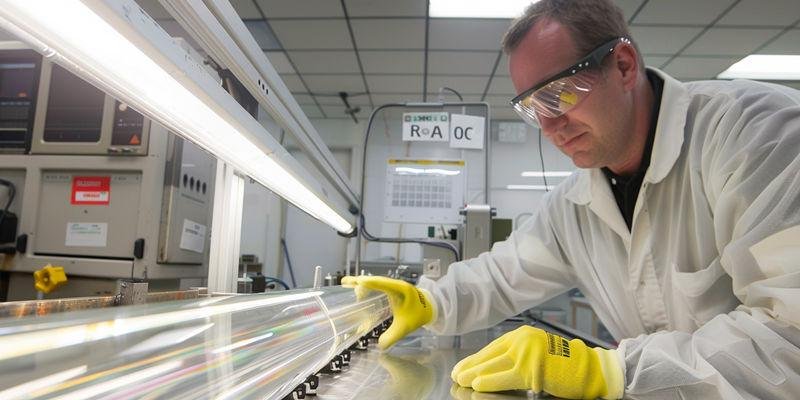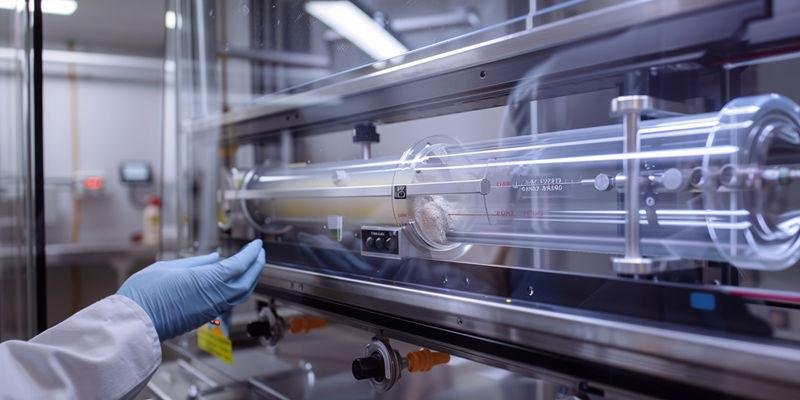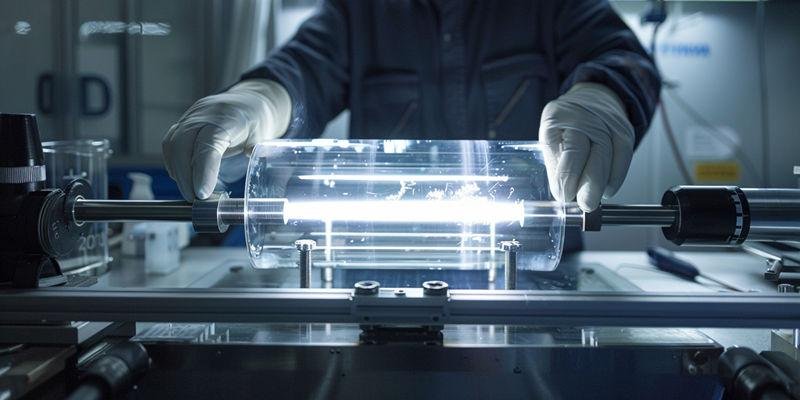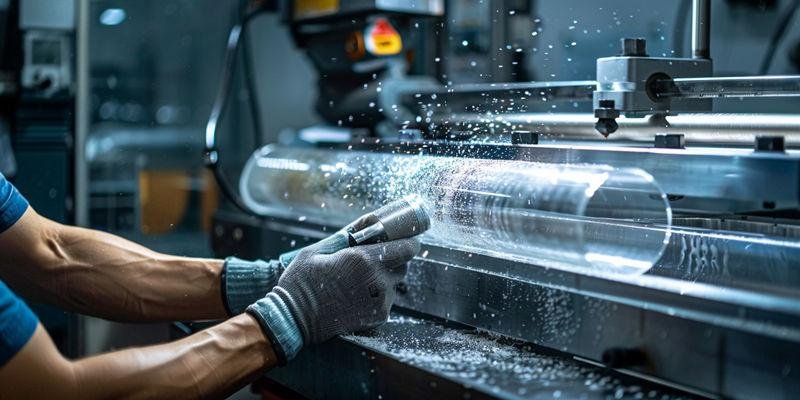
Accurate specification of custom length quartz tubes directly influences furnace efficiency, operator safety, and overall project cost. Engineers who select the correct tube length ensure proper thermal coverage and minimize installation risks. Mistakes in tube dimensioning can lead to equipment failure or expensive downtime. By understanding the technical factors behind tube selection, users can avoid common errors and achieve reliable, long-term furnace performance.
Key Takeaways
Selecting the right tube length is crucial for furnace efficiency and safety. Engineers should match tube specifications to furnace requirements to avoid costly mistakes.
Understanding standard length categories by tube diameter helps streamline procurement. Smaller diameters allow for longer lengths, while larger diameters have shorter standard lengths.
Extended length capabilities can cover larger furnace hot zones. Engineers must consider handling challenges and dimensional accuracy when specifying tubes longer than 1,500mm.
Choosing the right cutting method, like diamond sawing or laser cutting, ensures precise dimensions and maintains tube performance. This choice impacts thermal resistance and installation success.
Prioritizing quality and delivery over initial cost leads to long-term reliability. Users should consider total ownership costs, including maintenance and shipping, when selecting quartz tubes.
What Length Ranges Are Available for Custom Quartz Tubes?

Selecting the right tube length is essential for achieving optimal furnace performance and safety. Engineers must understand how tube diameter, manufacturing capabilities, and dimensional tolerances influence the available length ranges. This section explains why these factors matter and how they affect the specification process for custom length quartz tubes.
Standard Length Categories by Tube Diameter
Manufacturers offer standard length categories based on tube diameter to simplify selection and ensure compatibility with common furnace designs. Smaller diameters typically allow for longer stock lengths, while larger diameters require shorter standard lengths due to handling and production constraints. These categories help engineers match tube specifications to furnace requirements and streamline procurement.
Standard length categories support efficient manufacturing and reduce waste. Tubes with diameters under 50mm often come in lengths up to 1,220mm, while larger diameters above 50mm are usually available in 1,520mm or 1,830mm lengths. This approach enables users to select the most suitable configuration for their application, minimizing the need for extensive customization.
The following table summarizes typical standard length categories by tube diameter:
Diameter (mm) | Standard Length (mm) |
|---|---|
5–50 | 1,220 |
51–100 | 1,520 |
101–300 | 1,830 |
N/A | 20–1,400 |
N/A | 48″ |
Extended Length Manufacturing Capabilities (2,000–5,000mm)
Engineers often require extended lengths for custom quartz tubes to cover larger furnace hot zones or specialized applications. Manufacturers can produce tubes up to 5,000mm, but longer tubes introduce challenges in maintaining straightness and dimensional accuracy. These capabilities allow users to specify tubes that meet unique process requirements.
Extended lengths demand specialized manufacturing methods and equipment. Tubes longer than 1,500mm require careful handling during production to prevent bowing and maintain concentricity. For lengths above 2,500mm, segmented designs with precision joining may offer better performance than monolithic tubes, especially when strict tolerances are necessary.
Key reasons for considering extended length capabilities include:
Coverage of large furnace hot zones
Reduction of installation joints
Improved temperature resistance and process uniformity
Support for custom length quartz tubes in advanced applications
Length Impact on Dimensional Tolerance Maintenance
Tube length directly affects the ability to maintain dimensional tolerances during manufacturing and installation. Longer tubes present greater challenges in achieving consistent straightness and wall thickness, which can impact fit and performance in high-temperature furnaces. Engineers must specify tolerances that balance manufacturing feasibility with application needs.
Strict length tolerances enhance manufacturing efficiency by minimizing waste and rework. Variations in tube length can lead to assembly issues and reduced functionality, especially in precision-critical industries such as semiconductor processing. Manufacturers use advanced metrology to verify that custom quartz tubes meet required specifications.
The table below highlights why length tolerance matters for custom tube applications:
Reason for Tolerance | Impact on Application |
|---|---|
Dimensional accuracy | Ensures proper tube fit |
Manufacturing yield | Reduces waste and rework |
Performance | Maintains temperature resistance |
How Does Tube Diameter Affect Maximum Achievable Length?
Tube diameter plays a critical role in determining the maximum length that manufacturers can achieve for quartz tubes. Engineers must understand why diameter influences straightness, tolerance, and manufacturing methods. This knowledge helps them select the right tube for high-temperature furnace applications and avoid costly specification errors.
Small Diameter Tubes (5-50mm OD) - Length Optimization
Small diameter quartz tubes allow for longer lengths due to their structural stability and ease of handling. Manufacturers often use continuous draw or Danner process methods for these tubes, which support lengths up to 3,000mm and diameters as small as 5mm. These processes maintain tight wall thickness tolerances and straightness, making small diameter tubes ideal for applications requiring precise positioning and uniform temperature resistance.
In high-temperature furnace applications, engineers optimize small diameter tubes by adjusting filament and coil designs to maximize power output and minimize localized heating. This approach reduces the risk of envelope failure and supports higher power density under controlled conditions. Custom length quartz tubes in this size range can be tailored to specific furnace designs, ensuring efficient thermal coverage.
Key reasons for optimizing small diameter tubes include:
Longer achievable lengths (up to 3,000mm)
Consistent wall thickness and straightness
Enhanced temperature resistance and power density
Large Bore Tubes (100-300mm OD) - Manufacturing Constraints
Large bore quartz tubes face more significant manufacturing constraints that limit their maximum achievable length. As diameter increases, the risk of bowing, wall thickness variation, and stress cracking rises, especially during cooling and handling. Manufacturers typically cap single-piece lengths for tubes in the 100-300mm OD range at 1,500-2,500mm to maintain quality and dimensional accuracy.
Production methods such as rotational drawing and formed tube techniques help control wall thickness and roundness for large diameters. These methods require specialized equipment and slower production speeds to prevent defects. Handling and cooling large bore tubes also demand extended annealing times and careful support to avoid stress-induced failures.
The following table summarizes key manufacturing methods and their impact on large bore tube production:
Manufacturing Method | Maximum Length | Wall Thickness | Diameter Range |
|---|---|---|---|
Rotational Drawing | 2,500mm | ±10% | 50-300mm |
Formed Tube | 3,000mm | ±8% | 80-300mm |
Diameter-to-Length Ratio Engineering Guidelines
Engineers rely on diameter-to-length ratio guidelines to ensure quartz tubes meet application-specific requirements. The optimal ratio depends on factors such as sample size, heating needs, and furnace design. For example, rotating tube furnaces require diameters that allow smooth rotation without friction, while static furnaces may prioritize length for greater hot zone coverage.
Standard diameters include 25mm, 50mm, 75mm, and 100mm, but custom diameters can be manufactured for unique needs. The brittleness of quartz limits the maximum ratio, so engineers must balance tube length with structural integrity and temperature resistance. Application-specific guidelines help prevent failures and ensure reliable furnace operation.
Key engineering considerations for diameter-to-length ratio include:
Sample size and volume requirements
Uniform heat distribution
Application-specific design needs
What Cutting Methods Maintain Dimensional Accuracy for Custom Lengths?
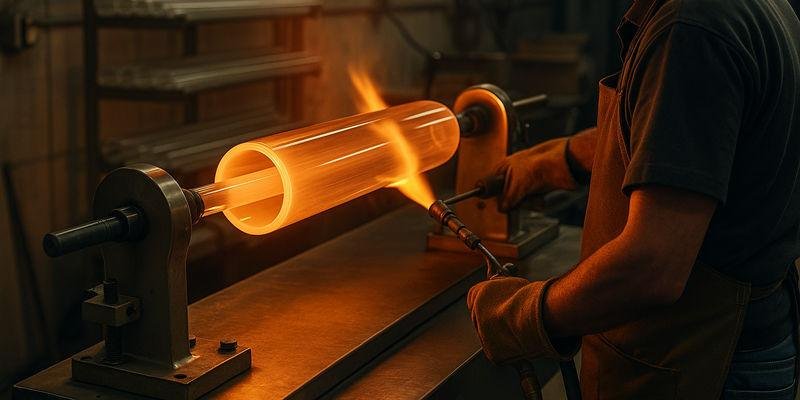
Engineers must select the right cutting method to achieve precise dimensions and reliable performance in custom length quartz tubes. Each technique offers unique advantages for maintaining straightness, wall thickness, and edge quality. Understanding why these methods matter helps users optimize tube selection for thermal resistance and installation success.
Diamond Sawing - Tolerance Specifications
Diamond sawing provides high accuracy for cutting quartz tubes to custom lengths. This method uses a diamond blade to achieve tight tolerances, which is essential for applications that require precise tube fit and alignment. Manufacturers rely on diamond sawing because it minimizes mechanical stress and maintains wall thickness consistency.
Dimensional tolerances achieved by diamond sawing typically reach ±0.05mm for wall thickness and ±0.1mm for diameter. These tolerances ensure that tubes fit securely in furnace assemblies and support consistent thermal performance. Automated CNC equipment further improves perpendicularity, which is critical for maintaining straightness in long tubes.
The following table highlights the dimensional tolerances for common cutting methods:
Cutting Method | Dimensional Tolerances |
|---|---|
Manual Cutting | ±0.05mm wall thickness, ±0.1mm diameter |
Mechanical Cutting | ±0.05mm wall thickness, ±0.1mm diameter |
Diamond Blade Cutting | ±0.05mm wall thickness, ±0.1mm diameter |
High-Frequency Plasma Cutting | ±0.05mm wall thickness, ±0.1mm diameter |
Laser Cutting - Edge Quality Considerations
Laser cutting offers a non-contact method for producing custom length quartz tubes with excellent edge quality. This process uses focused energy to create clean cuts, which reduces the risk of microcracks and supports high dimensional accuracy. Engineers choose laser cutting for applications that demand minimal mechanical stress and smooth surfaces.
Edge quality depends on several factors, including material thickness and laser parameters. Thicker tubes require adjustments to cutting speed and power to prevent rough edges, while thinner tubes yield cleaner cuts but are more sensitive to changes in cutting conditions. The tube’s wall thickness and the laser beam size also influence the minimum recommended hole size for tube parts.
Key points to consider when evaluating laser cutting for quartz tubes include:
Thicker materials need optimized cutting parameters for best edge quality
Thinner materials produce cleaner edges but require precise control
Wall thickness and beam size affect hole design and cut accuracy
Fire-Polishing Requirements for Thermal Shock Resistance
Fire-polishing is essential for enhancing the thermal shock resistance of custom length quartz tubes. This finishing technique uses a controlled flame to round and smooth cut edges, which helps prevent stress concentrations and tube rupture during rapid temperature changes. Engineers specify fire-polishing to improve tube durability in high-temperature furnace environments.
Edge finishing methods such as fire-polishing, grinding, and polishing directly impact both thermal shock resistance and optical quality. The excellent thermal shock performance of quartz results from smooth, rounded edges that distribute stress evenly. Polishing levels can be tailored to meet specific application needs, which improves surface quality and optical clarity.
The table below summarizes why edge finishing matters for thermal shock resistance and optical applications:
Edge Finishing Method | Benefit | Application |
|---|---|---|
Fire-Polishing | Prevents rupture, improves durability | High-temp furnaces |
Grinding/Polishing | Enhances optical clarity | UV/optical systems |
What Quality Standards Validate Custom Length Quartz Tube Performance?
Quality standards play a vital role in ensuring that custom length quartz tubes deliver reliable performance in high-temperature furnace environments. Engineers need to know why these standards matter for dimensional accuracy, material purity, and thermal resistance. By following recognized protocols, users can trust that their high-purity quartz tubes will meet demanding operational requirements.
Dimensional Inspection Standards for Extended Length Tubes
Dimensional inspection standards help manufacturers maintain precise tube geometry over extended lengths. These standards ensure that each tube fits correctly in furnace assemblies and supports consistent heating profiles. Accurate inspection prevents costly installation errors and equipment downtime.
Manufacturers use ISO and ASTM standards to verify dimensional accuracy and wall thickness. ISO 9001 provides a framework for quality management, while ASTM C100 sets requirements for dimensional accuracy and material purity. These standards require three-point measurement verification and strict tolerance checks along the tube length.
The following table summarizes key standards for dimensional inspection:
Standard | Purpose |
|---|---|
ISO 9001 | Quality management for consistent manufacturing |
ASTM C100 | Dimensional accuracy and material purity requirements |
Material Certification Requirements (ISO 12123 Compliance)
Material certification requirements validate that each tube meets strict purity and performance criteria. Certification ensures that high-purity quartz and fused quartz tubes provide the necessary optical and thermal properties for advanced furnace applications. Reliable documentation gives engineers confidence in the tube’s suitability for critical processes.
Suppliers must provide certificates that confirm compliance with ISO 12123 for thermal stability and MIL-PRF-13830B for optical clarity. Critical parameters include wavelength compatibility, surface accuracy, and coating durability. Adherence to IEC 60825-1 and RoHS/REACH standards further ensures safety and environmental compliance.
Key certification requirements include:
ISO 12123 for thermal stability
MIL-PRF-13830B for optical clarity
IEC 60825-1 for laser safety
RoHS/REACH for hazardous substance restrictions
Thermal Performance Validation Testing Methods
Thermal performance validation confirms that custom quartz tubes withstand repeated heating and cooling cycles without failure. This testing is essential for applications that demand high thermal resistance and long service life. Engineers rely on these tests to prevent unexpected tube failures in high-temperature furnaces.
Manufacturers use ASTM and ISO methods to test thermal cycling, softening points, and expansion coefficients. Batch test certificates provide a full property sheet, while thermal cycling tests (ASTM C1525) and softening point proofs (ASTM C338) verify tube durability. Suppliers validate expansion coefficients using ASTM E831 to ensure consistent performance.
The table below outlines recommended validation methods:
Verification Item | Data Provided | Recommended Test/Standard | Frequency |
|---|---|---|---|
Batch Test Certificate | Full property sheet | ASTM/ISO methods | Every batch |
Thermal Cycling Test | ≥1000 cycle report | ASTM C1525 | Once per design type |
Softening/Flow Point Proof | Lab measurement | ASTM C338 | Per supplied grade |
Expansion Coefficient | Measured result | ASTM E831 | Supplier validation |
How to Optimize Lead Time and Cost for Custom Length Quartz Tubes?
Efficient procurement of custom quartz tubes depends on understanding how specification choices affect both delivery timelines and overall costs. Engineers must evaluate why standard options offer faster turnaround and how custom features can extend lead times. By identifying key cost drivers and applying proven strategies, users can achieve reliable performance while controlling expenses.
Lead Time Comparison - Standard vs Fully Custom Specifications
Lead time plays a crucial role in project planning for high-temperature furnace installations. Standard cut-to-length tubes ship quickly because manufacturers keep common sizes in stock. Fully custom specifications require additional production steps, such as drawing approval and specialized fabrication, which increases delivery time.
Manufacturers typically deliver standard cut-to-length tubes within seven days. Custom tubes, especially those with unique diameters or special finishes, may take one to four weeks after drawing approval. This difference impacts scheduling for maintenance and new installations.
The following table highlights typical lead times for each specification type:
Specification Type | Lead Time |
|---|---|
Standard Cut-to-Length | Within 7 days |
Fully Custom Specifications | 1 to 4 weeks after drawing approval |
Cost Drivers in Custom Length Fabrication
Cost optimization starts with understanding why certain factors increase the price of custom quartz tubes. Purity of raw materials, energy consumption during fusion, and complexity of manufacturing processes all contribute to final costs. Minimum order quantities and specific requirements for custom shapes also affect pricing.
Engineers can reduce costs by bulk purchasing high-purity materials and streamlining manufacturing processes to minimize waste. Standardizing designs where possible and adjusting minimum order quantities based on demand further lowers expenses. Improving energy efficiency during production also helps control costs.
The table below summarizes major cost drivers and effective optimization strategies:
Cost Driver | Optimization Strategy |
|---|---|
Purity of raw materials | Bulk purchasing of high-purity materials |
Energy consumption during fusion | Improving energy efficiency in production |
Complexity of manufacturing process | Streamlining manufacturing processes to reduce waste |
Minimum order quantities (MOQs) | Adjusting MOQs based on demand |
Specific requirements for custom shapes | Standardizing designs where possible |
Decision Matrix for Selecting Specification Strategy
Selecting the optimal specification strategy requires a clear understanding of application needs and supplier capabilities. Engineers must consider operating temperature, size tolerances, purity, and shock resistance when choosing between standard and custom options. Documented supplier controls and ISO 9001 certification ensure consistent quality.
A decision matrix helps users match requirements to recommended specifications and verification methods. For example, applications needing continuous operation at 1,100°C should specify tubes with ≥99.9% SiO₂ purity and strict straightness tolerances. Cleanliness and documented supplier controls further support reliable performance.
The table below provides a decision matrix for specification strategy selection:
Requirement | Recommended Specifications | Verification |
|---|---|---|
Operating Temperature (°C) | 1000-1100 continuous; ≤1200 peak | Service profile review |
Size and Tolerances | OD/ID/Length with ±0.25 mm typical | MMC report |
Emissivity | Target ≥0.90 mid-IR | IR reflectance trend |
Shock Expectation | Define cycle; specify handling class | Thermal cycle test |
Purity | ≥99.9% SiO₂ | CoC / ICP-OES |
Straightness/Ovality | ≤0.3 mm/m; ≤0.5% | Gauge/fixture |
Cleanliness | Neutral detergents, deionized water, baking | Procedure record |
Supplier | Documented controls, ISO 9001 | Audit summary |
Tip: Engineers can further optimize procurement by ordering multiples of stock lengths, accepting standard end finishes, and establishing blanket purchase orders for recurring needs. These strategies help reduce costs and ensure timely delivery of synthetic quartz and custom quartz tubes.
Specifying custom length quartz tubes for high-temperature furnaces requires careful planning and attention to detail.
Define all dimensions.
Specify purity, optical, and chemical requirements.
Request a feasibility review before ordering.
The engineering team supports flexible solutions and fast turnaround, helping users balance technical needs with manufacturing realities. M-Kube Enterprise offers custom fabrication and reliable service to meet lead times.
Long-term reliability and cost efficiency depend on prioritizing quality and delivery over initial cost. Cheaper tubes may increase maintenance and replacement expenses, so users should consider total ownership costs, including shipping and import fees.
FAQ
Why do engineers specify custom lengths for quartz tubes in high-temperature furnaces?
Engineers specify custom lengths to match furnace hot zones, improve thermal uniformity, and reduce installation joints. Custom sizing helps achieve optimal performance and safety.
Why does tube diameter affect the maximum achievable length?
Tube diameter impacts structural stability and manufacturing limits. Larger diameters increase the risk of bowing and stress cracking, which restricts the maximum length manufacturers can produce.
Why is fire-polishing recommended for cut quartz glass tubes?
Fire-polishing smooths cut edges, reducing stress concentrations. This process increases thermal shock resistance and extends tube lifespan in high-temperature environments.
Tip: Always request fire-polished ends for furnace tubes to maximize durability.
Why do manufacturers provide material certification for quartz tubes?
Material certification verifies purity and thermal stability. These documents ensure that quartz tubes meet strict industry standards for reliable furnace operation.
Certification Type | Purpose |
|---|---|
ISO 12123 | Thermal stability |
ASTM C1525 | Shock resistance |
Why should users consider lead time when ordering custom quartz tubes?
Lead time affects project scheduling and maintenance planning. Standard sizes ship faster, while fully custom tubes require more production time.



